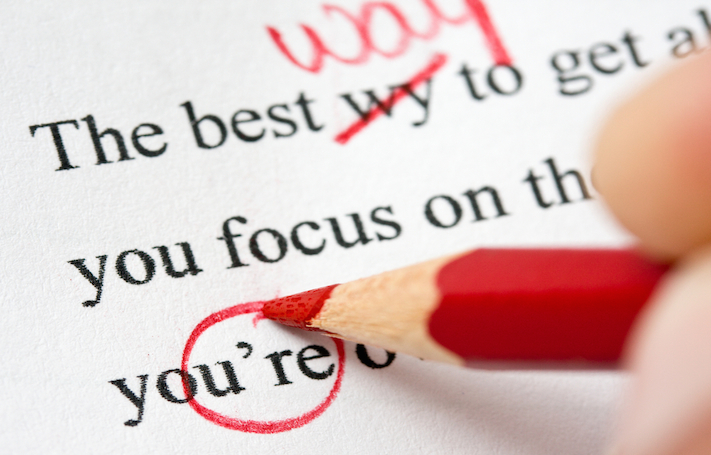
As a business leader, you want to sound smart. But when something as small as a misplaced comma can distort your meaning and weaken your credibility, grammar rules become a lot more important.
Creating concise, engaging, and error-free content is tough, especially when you’re following grammar rules that, while imparted with good intentions, are just wrong. Although it’s hard to believe your beloved elementary school teachers would lead you astray; grammar is an essential part of the curriculum, after all. Like most of us, I remember the agonizing hours of diagramming sentences and listening to Hooked on Phonics cassette tapes.
But as I got older, I developed my writing level beyond the fifth grade and uncovered a new world of grammar rules — some of which contradicted the words my elementary teachers once engrained in my head.
Here are just a few grade school grammar rules that turned out to be false:
1. Always/never use the Oxford comma.
This rule seemed to change with the seasons. One year, I was told to use the Oxford comma, and the next, I was scorned for even considering it.
Commas are probably the most frequently used punctuation mark, and that’s what makes them so tricky. There are countless comma rules for varying situations, and even grammarphobes have mixed emotions about when to use them. Some rules are firm (e.g., never place a comma between a subject and a verb) while others are more suggestive, which is where the Oxford comma — the comma before “and” in a series of items — comes into play.
So should you use it or not? The answer is that you can do either because it’s a style preference; just make sure you keep it consistent. At Influence & Co., we use the Oxford comma, but some publications such as Entrepreneur don’t. The moral of the story is to never confuse punctuation rules with style preferences.
2. Place a comma where you pause.
This is yet another comma rule. Actually, it’s not a rule at all. I distinctly remember being told this grammar “hack” — to just put a comma anywhere you would naturally pause when speaking. But even then, I was skeptical.
Sometimes you’ll get lucky and place the comma correctly, but this rule is unreliable at best, and it often leads to tragic comma abuse. Commas create natural pauses for readers, and overusing them can make your sentences difficult to decipher or, even worse, interrupt the flow and cause readers to check out. And if you throw in some comma splices amid the frenzy, you’ll convolute your message and confuse readers even more.
I can’t cover all the comma rules of the universe, but I do recommend purchasing or borrowing a copy of Brian Brooks’ “Working with Words” or consulting one of my favorite online tools, Grammar Girl, for more in-depth explanations.
3. Never start a sentence with a conjunction.
OK, I understand why this one was a rule — the operative word being was. My teachers didn’t want me to start every sentence with “and” or “but,” as children are prone to doing. But instead of simply explaining their rationale, they banned it altogether.
Sometimes starting a sentence with “and” or “but” can enhance the flow of a sentence and is much less obtrusive than using the adverb “additionally,” for example. As an added bonus, it’s grammatically correct. Heck, even Shakespeare began sentences with conjunctions.
4. Never end a sentence with a preposition.
This rule actually stems from Latin grammar, where prepositions always come before prepositional objects. I know what you’re thinking: Latin and English are not the same. Still, this faulty rule continues to spread through elementary schools like a bad case of the chickenpox.
For those who are a little rusty on their syntax and grammar, a preposition is a word that links the verb, noun, or adjective to the noun or pronoun in a sentence. For example, in the sentence “He’s hungry for watermelon,” “hungry” is the adjective, “watermelon” is the noun, and “for” is the preposition that connects the two.
Although prepositions are usually found before the noun or pronoun, there are instances when ending a sentence with a preposition is OK. Infinitive structures, for instance, usually end in prepositions, and so do most questions beginning with who, where, and what (e.g., “Where did you come from?”). You can restructure these sentences to sandwich in the preposition if you’d like, but avoid this if it makes the sentence sound awkward or overly formal.
There are instances when ending sentences with a preposition is unnecessary, though. If the preposition can be removed from the sentence and still maintain its meaning, then including the preposition is just repetitive. For example, “Where’s the party at?” would work just as well without the “at.”
As an honorable mention, I thought I’d address the age-old “I before E except after C” adage. While it’s pithy, it’s not a finite rule. Look at the words eight, protein, height, their — need I continue? Although this catchy saying might have helped our budding minds navigate those tricky “ie” and “ei” words, we need to remember that it doesn’t apply in every situation.
So what’s the best way to learn the rules of grammar without having to work through dozens of repetitive worksheets? It’s simple: Just sit down and write. I didn’t find my love for grammar, punctuation, and syntax through grammar lessons; I discovered it by writing whenever I could. And while my teachers undoubtedly taught me a lot of great things, grammar is one area where I needed to take the reins. In fact, studies indicate that traditional grammar lessons aren’t effective and can even hinder a student’s ability to learn proper grammar.
So if you remember nothing else, remember this: English teachers are like automated grammar checkers. They’re helpful, but you can’t always rely on them.
What grade school grammar lessons did you learn that turned out to be false?








